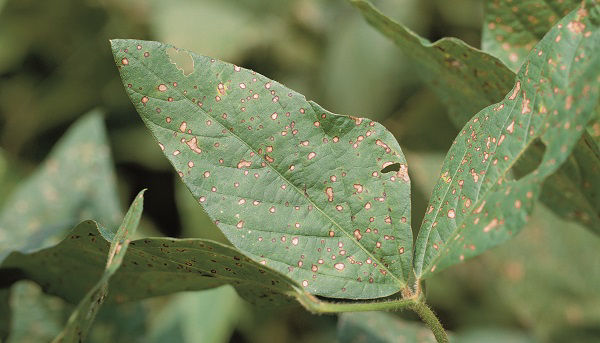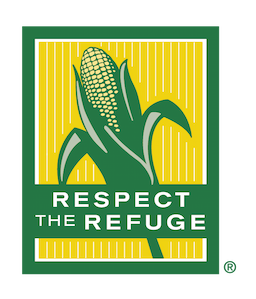Prevent the Return of Last Year’s Yield-Robbing Diseases
December 27, 2018

Next year’s disease problems may be lingering in your harvested fields. Many disease pathogens overwinter on plant debris and survive in the soil into the next growing season. Left unmanaged, the surviving pathogens will wait for the optimal conditions to infect next season’s crops and ultimately reduce yields.
But with careful observation, planning and prevention, disease implications can be greatly reduced.
Disease prevention begins long before planting. “The first step in disease prevention is knowing the disease history of the field,” said Randy Myers, fungicides product development manager at Bayer. “Identification of last season’s diseases is one of the most effective tools for planning to proactively manage disease in the upcoming growing season.”
An important part of disease management is scouting your fields throughout the season to look for disease. Take notes about or pictures of the diseases present. Some diseases seem to share visible symptoms and may be difficult to diagnose. Consult with an agronomist or extension agent to better understand the signs and accurately identify disease in your field. Accurate identification is the key to managing disease in the current growing season and preventing disease in future growing seasons.
Common corn diseases
Common soybean diseases include gray leaf spot, northern corn leaf blight, southern rust and anthracnose leaf blight.
Gray leaf spot: After long periods of high humidity and warm, wet weather, gray leaf spot first appears as small spots with halos. As the disease progresses, the spots elongate to rectangular lesions, typically gray to brown in color, one-eighth inches in width and up to three inches in length.i Gray leaf spot is most commonly found throughout the corn belt states and can reduce yields by up to 40 bushels per acre.
Northern corn leaf blight: Wet and humid weather conditions foster the development of northern corn leaf blight. The disease is identified by its oblong lesions that are grayish-green or tan in color and are one to seven inches long. The lesions first appear on the lower leaves and can spread throughout the plant up to the husks. Northern corn leaf blight is most damaging to crops if present during tasseling or silk development. During this time, the disease has the potential to reduce yields by 50 percent.ii
Tar spot: Cooler temperatures with high humidity and frequent rainfall are favorable conditions for tar spot to develop. The disease appears as a series of black spots on corn leaves. When tar spot infects a host, it can cause reduced photosynthesis, resulting in poor stalk quality and standability. First found in the Midwest in 2015, tar spot has the potential to reduce yields by up to 30 to 40 bushels per acre.iii
Southern rust: High humidity and temperatures above 80 degrees provide a favorable environment for southern rust to develop. Southern rust is characterized by its small, bright orange pustules surrounded by a light green to yellow halo. The pustules are densely clustered on the upper leaf surface. The disease is more common in the south, but it has been found to affect corn fields in northern states in recent years as well. Southern rust causes the most yield losses when it occurs prior to the R3 or “milk” growth stage.iv
Anthracnose leaf blight: First appearing as a leaf blight on lower leaves with uneven brown spots, anthracnose leaf blight develops during extended periods of cloudy, wet and warm weather. The spots spread to the upper leaves, can grow to three-quarters inches long and will become tan in the center, with a yellow, red or brown border. Anthracnose leaf blight can also cause stalk rot, stem rot or eventual death of the plant, resulting in reduced grain fill and yield loss. The disease can also cause lodging, which reduces harvest ease and efficiency.
Common soybean diseases
There are also several common diseases that can be seen in soybean fields. These include frogeye leaf spot, brown spot, white mold and aerial blight.
Frogeye leaf spot: Consistent, high humidity provides favorable conditions for development of frogeye leaf spot. This fungal disease first appears as small, dark spots with purple borders on leaves, stems and pods. The spots will progress to appear gray to brown with reddish borders and will enlarge to one-quarter inch in diameter.v Frogeye leaf spot has been found to reduce yields by up to 30 percent.vi
Brown spot: Any warm, wet weather that occurs between planting and canopy is favorable for brown spot development. The disease first appears as purple lesions that progress into irregularly-shaped, dark brown lesions. Brown spot can cause noticeable damage to soybean plants, such as yellow, dropped leaves, stunted pod fill and reduced yields.vii
White mold: Cooler temperatures and significant rainfall near flowering create ideal conditions for white mold to develop. White mold appears as a cotton-like growth on the stems. Soybeans affected by white mold may wilt and appear to be bleached and may die or dry out during flowering. Most common in the north central United States, white mold can reduce yields by two to five bushels per acre for every 10 percent increase of the fungus.viii
Aerial blight: During long periods of high humidity and warm temperatures, aerial blight is likely to first appear as reddish-brown lesions on the petioles, steams and pods of soybeans. Eventually, the disease may evolve in appearance to web-like hyphae, the branching structures of the fungus, that spread along affected tissue. Aerial blight is most common throughout the southern United States and has been found to cause yield losses of up to 50 percent.ix
Proactively plan to fight disease in the next growing season
It is important to always be aware of the disease pressures in your fields. Last year’s yield-robbing diseases can overwinter in your fields and infect crops planted in the next growing season. Therefore, it is important to take a proactive approach to disease management to prevent disease before it starts. This means taking action immediately after harvest.
Tilling fields after harvest may reduce disease by helping bury disease residues into the soil and preventing them from surviving into the next growing season.
Crop rotation is also beneficial for minimizing disease. Rotating to a non-host crop prevents the proliferation of disease pathogens. Once all the host debris has decayed completely, the pathogens will die off before the host crop is planted in the field in a future growing season.x
In addition, effective planning and preparation can also help prevent disease in the upcoming growing season. Select a corn hybrid or soybean variety that is resistant to diseases commonly found in your fields, but caution that no corn hybrid or soybean variety is resistant to all diseases. For added disease prevention, choose a fungicide that complements your selected hybrid or variety to prevent disease before it begins.
“Using a fungicide with strobilurin and triazole components is a great way to proactively prevent disease in your fields,” said Myers. “Fungicide use can also improve plant health and could ultimately result in an increase in yield and profit.”
Two Bayer solutions for your disease control
Myers recommends using Delaro® fungicide for unmatched, broad-spectrum disease control. With two modes of action, Delaro provides preventive and curative effects to fight tough diseases and manage disease resistance in both corn and soybeans. In corn, Delaro prevents and manages diseases such as anthracnose leaf blight, gray leaf spot, northern corn leaf blight and southern rust. In soybeans, Delaro works to prevent and manage diseases such as aerial blight, brown spot, frogeye leaf spot and white mold. In addition, Delaro promotes healthy, dark green leaves for improved photosynthesis and increased stress resistance, resulting in improved plant health to better express the full genetic potential of your seed. Overall, as part of an integrated disease management program, Delaro may help prevent the previous year’s problem diseases in the upcoming growing season.
The new Delaro® Complete fungicide with three modes of action improves overlapping disease control, delivers better resistance management and even more consistent disease activity control, namely against gray leaf spot, brown spot and white mold. The additional mode of action helps promote healthier corn and soybean plants, and grow stronger corn stalks and broader soybean canopies – allowing plants to withstand environmental pressures for robust growth and yield preservation. In addition, Delaro Complete promotes healthy, dark green leaves for improved photosynthesis and increased stress resistance, as well as increased drought tolerance and standability. This new formulation works to improve plant health to better express the full genetic potential of your seed.
As part of an integrated disease management program, Delaro or Delaro Complete may help keep operations moving forward for corn and soybean growers in the upcoming growing season.
©2018 Bayer CropScience LP, 800 North Lindbergh Blvd. St. Louis, MO 63167. Always read and follow label instructions. Bayer, the Bayer Cross and Delaro are registered trademarks of Bayer. Delaro is not registered in all states. For additional product information call toll-free 1-866-99-BAYER (1-866-992-2937) or visit our website at www.CropScience.Bayer.us.
Sources:
i Malvick, D. “Gray leaf spot on corn.” University of Minnesota Extension, 2018. https://extension.umn.edu/corn-pest-management/gray-leaf-spot-corn
ii Paul, P. “Northern corn leaf blight: Earlier than usual this year.” Ohio State University Extension, Agronomic Crops Network, 2015. https://agcrops.osu.edu/newsletter/corn-newsletter/2015-19/northern-corn-leaf-blight-earlier-usual-year
iii MacKellar, B. “Tar spot is impacting corn yields and causing stalk lodging during harvest.” Michigan State University Extension, 2018. https://www.canr.msu.edu/news/tar-spot-impacting-corn-yields-and-causing-stalk-lodging-during-harvest
iv Fyksen, J. “Southern rust appears in Wisconsin.” Agri-View, 2017. https://www.agupdate.com/agriview/news/crop/southern-rust-appears-in-wisconsin/article_c4bbbb8e-9906-5e25-9e21-3a2eee3bb5c0.html
v Giesler, L.J. “Frogeye leaf spot of soybean.” University of Nebraska-Lincoln Extension, 2013. http://extensionpublications.unl.edu/assets/pdf/g2213.pdf
vi Kleczewski, Nathan. "Frogeye Leaf Spot on Soybean." University of Delaware Cooperative Extension, 2014. http://extension.udel.edu/factsheets/frogeye-leaf-spot-on-soybean-2/
vii Integrated Crop Management. “Septoria brown spot.” Iowa State University Extension and Outreach.https://crops.extension.iastate.edu/septoria-brown-spot
viii Giesler, L. “White mold more common this year in soybean.” Nebraska Extension: CropWatch, 2017. https://cropwatch.unl.edu/2017/white-mold-more-common-year-soybean
ix Faske, T., and Kirkpatrick, T. “Aerial blight of soybean.” University of Arkansas Extension. https://www.uaex.edu/farm-ranch/crops-commercial-horticulture/docs/Faske%209%20Aerial%20Blight.pdf
x Jensen, B., Liesch, P.J., Nice, G., Renz, M., and Smith, D. “Pest management in Wisconsin field crops.” University of Wisconsin – Extension, 2018. http://learningstore.uwex.edu/assets/pdfs/a3646.pdf






